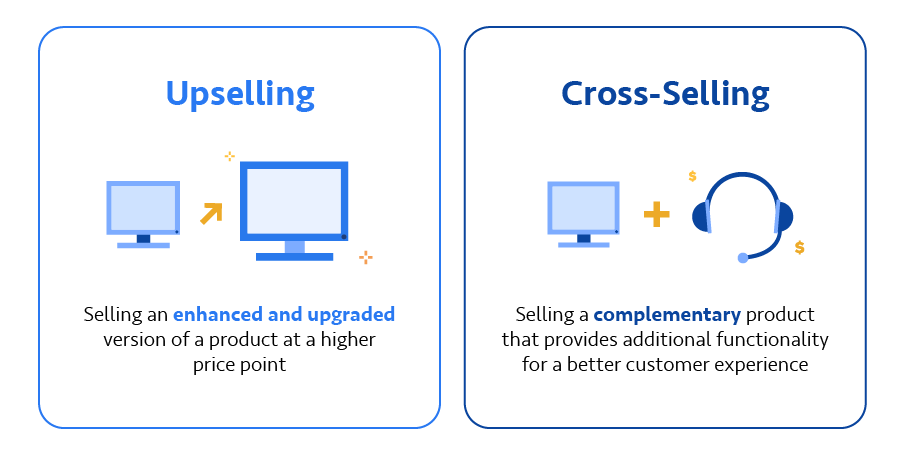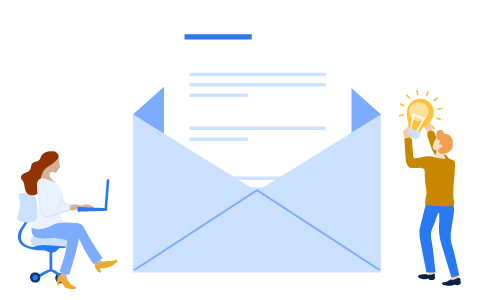Cross-sell vs Upsell in SaaS: 5 Proven Tactics and More


Tim Edwards
This post was originally published in March 2023 and has been updated for accuracy and comprehensiveness.
Acquiring a new customer as a SaaS business is expensive; on average, you’re looking at a $707 customer acquisition cost (CAC). That’s why upselling and cross-selling are important: They help future-proof your organization by digging deeper into your current customer base. But what is cross-sell vs upsell in SaaS?
In this post, we discuss:
- What is upsell vs. cross-sell
- Why cross-selling and upselling are important
- How to identify upsell opportunities
- 5 cross-selling and upselling strategies

The Ultimate Guide to B2B Customer Service Strategy
Learn how to turn customers into brand advocates using our free customer service strategy guide.
What is upsell vs. cross-sell
While many business leaders often use these two terms interchangeably, there are key differences between the two:

- Upselling: Selling an enhanced and upgraded version of a product at a higher price point
- Cross-selling: Selling a complementary product that provides additional functionality for a better customer experience
Sometimes, business leaders collectively call the two terms “suggestive selling.” Suggestive selling is the act of selling relevant add-ons or upgraded products to the customer.
We mentioned this earlier, but a big benefit of suggestive selling is that you are tapping into your existing customer database to find new opportunities as opposed to starting from scratch. We’ll go over the importance of suggestive selling in the next section.
Why cross-selling and upselling are important
Cross-selling and upselling are key to driving revenue for a B2B SaaS firm. In fact, larger SaaS companies with low churn rates all had one thing in common: they continuously cross-sold and upsold to over 33% of their existing customers.
There are three key benefits of cross-selling and upselling:
- Shorter sales cycle
- Increases customer lifetime value
- Increases customer satisfaction
Shorter sales cycle
The B2B SaaS sales cycle is notoriously long because it often involves large, expensive purchases where you have to win over multiple stakeholders — rather than just one individual consumer. The process of selling to a new customer is almost always longer than tapping into your existing customer base.
Studies show that the probability of selling to an existing customer is approximately 60-70%. That’s because these customers already see the value in your product and trust in your brand; it takes less effort to convince them to invest in your offerings. When you contrast that to the 5-20% probability of selling to a prospect in the same report, you can see why suggestive selling actually shortens the sales cycle.

Increases customer lifetime value
Customer lifetime value (CLV) is the total amount of money a customer is expected to spend with your business during their entire relationship with you. When you focus on cross-selling and upselling, your CLV will inherently increase your sales revenue.
Think about it: if your existing customers are spending more money during an upsell or cross-sell, your average customer’s spend has increased.
Increases customer satisfaction
Until your customers become brand advocates, they won’t be experts in your solutions; they’ll heavily rely on your salespeople and your customer success manager to recommend products that will better address their pain points.
A best practice here is to only cross-sell or upsell products that will enhance your customer experience. We’ll touch on why this is important later, but the main reason is to make sure your customers are truly benefiting from your product recommendations.
How to identify upsell opportunities
Since most SaaS businesses rely on subscription-based pricing models, you should not drain your customers financially before their contracts expire. Remember: Your overall goal with upselling and cross-selling is to increase customer lifetime value.
In most cases, your salespeople and customer support reps are responsible for upselling and cross-selling. That’s because they are the ones who directly interact with your customers on a personal level, so they can tailor their recommendations based on the customer’s unique needs.
Your first step? Look for customers who already love your products. Since they already see the value in your offerings, it’ll typically take less convincing to upsell to them.
EBQ Tip: Take a look at third-party review sites — such as G2. They often provide an unbiased view of your organization, as the reviewers are not incentivized to give you a positive review.
Read their reviews and look at their customer profile carefully before reaching out to them; you’ll often be able to preemptively identify which solution to suggest.
Your customer support reps should be regularly checking in on your customers to address any roadblocks and concerns they may have. Be sure to review your B2B SaaS sales process and identify when would be a good time to reach out. A few factors to consider include:
- How complex and customizable is your product?
- How many users do your customers expect to use your product?
- Do you have any compliance restrictions associated with your product?
- How much time does your customer spend on making decisions?
5 cross-selling and upselling strategies
Now that you know how to identify upselling opportunities, let’s look at EBQ’s five cross-selling and upselling strategies to improve your chances of success:
1. Become experts in your own products:
Your salespeople and customer service reps need to be familiar with every single product your business has to offer — including what unique pain point it aims to solve. That way, they can seamlessly introduce additional products to your customers whenever they see fit.
2. Only promote relevant products:
Too often than not, salespeople are incentivized to make as many sales as possible — causing them to blind sell to customers. However, this harms your business reputation, as your customers will not feel heard or valued. Instead, your team should only promote relevant products to your customers to help boost retention, even if it means downselling.
3. Focus on the value for the customer:
Look into creating bundling deals and discounted accessories. Even though you’re providing each product at a lower price point, you’re still ultimately increasing their customer lifetime value. And if you convey that the customer is getting a really good deal, they’re more likely to convert.
4. Do not increase the overall price by >25%:
Studies show that customers get disenchanted with your products as soon as the final price tag is over 25% of their original price. That’s why your team can’t be too aggressive in promoting additional products to your customers.
5. Use a CRM to identify opportunities:
If you haven’t already, make sure you invest in a CRM that quickly identifies opportunities on your behalf. That way, your reps need to do less of the heavy lifting to figure out which customers to upsell and cross-sell to.

The Ultimate Guide to B2B Customer Service Strategy
Learn how to turn customers into brand advocates using our free customer service strategy guide.
Our guide to cross-selling and upselling
Both cross-selling and upselling are great strategies for increasing your SaaS business’s revenue. Throughout this post, we looked at some tips and best practices for successfully implementing suggestive selling. By properly incorporating cross-selling and upselling into your SaaS sales strategy, you can increase your revenue and provide customers with a better experience.
If you’re looking to invest in sales reps who understand how to properly upsell to your customers, be sure to check out our outsourced sales service page. With our proven process, our salespeople can quickly learn your unique workflow to help you build a stronger sales pipeline.

